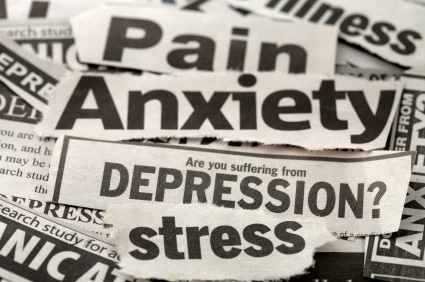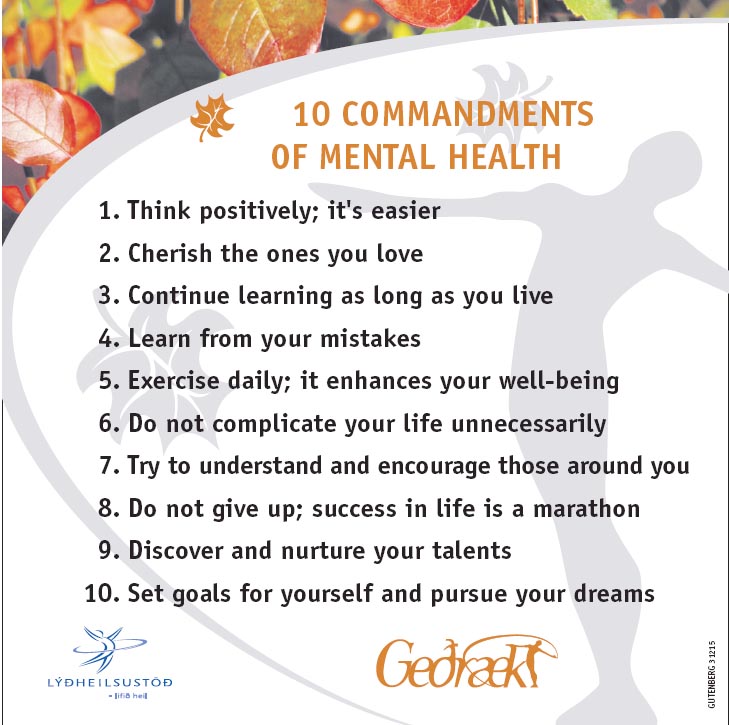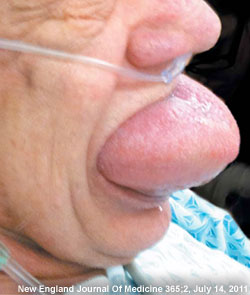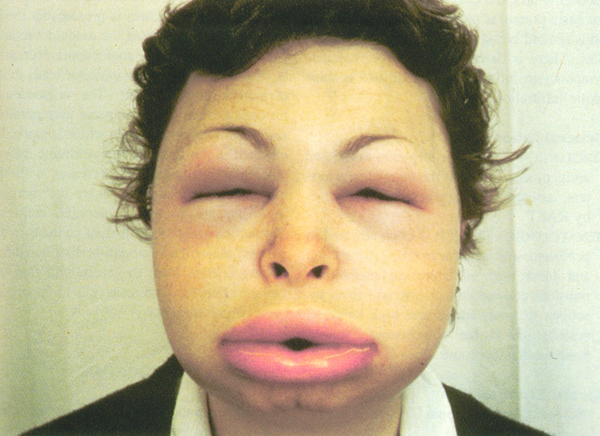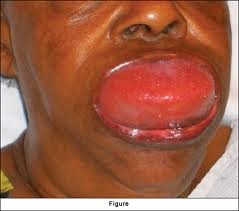Our latest reader submission strikes at the heart of the age-old concern about the relationship between our environment and our mind. It is important to appreciate that mental illness is often influenced by external factors, such as environmental stimulants. When we describe psychosocial disorders, we’re talking about mental illness precipitated by these factors. These factors include everything from family, religion, friends and cultural considerations. Yes, the situations you place yourself in can be hazardous to your health!
For the full blog on this topic, visit us at SterlingMedicalAdvice.com. Thanks for liking and following Straight, No Chaser! This public service provides a sample of what http://www.SterlingMedicalAdvice.com (SMA) offers. Please share our page with your friends on WordPress, and we can be found on Facebook at SterlingMedicalAdvice.com and on Twitter at @asksterlingmd.
Tag Archives: Disease
From the Health Library of SterlingMedicalAdvice.com: "What are psychosocial disorders?"
Straight, No Chaser: Keys to Mental (Un)Health and (Un)Happiness
Everyone has thoughts about the keys to happiness, but we can objectify the conversation and identify what’s most likely to make you unhappy and lead to depression. You may find this hard to believe, but outside of medical causes of psychiatric illness and factors outside of your control, there are actually three choices we make that most commonly adversely impact your happiness and good mental health. Take it for what you will, but the data is what it is. Stay away from these circumstances, and you’re less likely to be unhappy. Sometimes it’s about addition by subtraction.
Health Problems: People who are sick or have significant illness in their families generally aren’t happy. Although this may seem obvious and perhaps unfair, given that some illnesses and conditions are inherited or occur haphazardly, be mindful of the things you can control. Of course, this gets to the negative effects of obesity and smoking. More so than any other health-related activities/conditions, these will eventually lead to deteriorating health and subsequent unhappiness.
Job Problems: You don’t have enough to do with your time? Yep, an idle mind is the Devil’s workshop, as the saying goes. It should be pointed out that neither too much work nor the wrong type of work (i.e., low job satisfaction) seems to promote happiness. On average, people change careers seven times during their lifetimes. It’s often due to a search for happiness and actually is a good thing to do to avoid being stuck in a bad situation. Follow the job you love, and you’re more likely to be both happy and successful.
Relationship Problems: You make bad relationship choices? Well there’s one specific choice that is shown to be most likely to reduce your happiness—choosing a neurotic partner. What’s neurotic? For one particularly disruptive example, think about the so-called Drama Queen/King. A neurotic partner responds emotionally to events that wouldn’t affect most people, and their reactions tend to be more intense than normal. They’re more likely to interpret minor frustrations as hopelessly difficult. Their negative emotional reactions persist for unusually long periods of time. In short, if you want to be really unhappy, become attached to such a person. They will negatively affect your world, keeping you embroiled in drama and unhappiness, no matter how good the financial, physical, or other parts of your relationship.
Now your results may vary but probably won’t. I’m not make judgements, just sharing the data. Life choices have consequences. Choose wisely!
Thanks for liking and following Straight, No Chaser! This public service provides a sample of what http://www.SterlingMedicalAdvice.com (SMA) will offer beginning November 1. Until then enjoy some our favorite posts and frequently asked questions as well as a daily note explaining the benefits of SMA membership. Please share our page with your Friends on WordPress, and we can be found on Facebook at SterlingMedicalAdvice.com and on Twitter at @asksterlingmd.
Copyright © 2013 · Sterling Initiatives, LLC · Powered by WordPress
Everyone has thoughts about the keys to happiness, but we can objectify the conversation and identify what’s most likely to make you unhappy and lead to depression. You may find this hard to believe, but outside of medical causes of psychiatric illness and factors outside of your control, there are actually three choices we make that most commonly adversely impact your happiness and good mental health. Take it for what you will, but the data is what it is. Stay away from these circumstances, and you’re less likely to be unhappy. Sometimes it’s about addition by subtraction.
Health Problems: People who are sick or have significant illness in their families generally aren’t happy. Although this may seem obvious and perhaps unfair, given that some illnesses and conditions are inherited or occur haphazardly, be mindful of the things you can control. Of course, this gets to the negative effects of obesity and smoking. More so than any other health-related activities/conditions, these will eventually lead to deteriorating health and subsequent unhappiness.
Job Problems: You don’t have enough to do with your time? Yep, an idle mind is the Devil’s workshop, as the saying goes. It should be pointed out that neither too much work nor the wrong type of work (i.e., low job satisfaction) seems to promote happiness. On average, people change careers seven times during their lifetimes. It’s often due to a search for happiness and actually is a good thing to do to avoid being stuck in a bad situation. Follow the job you love, and you’re more likely to be both happy and successful.
Relationship Problems: You make bad relationship choices? Well there’s one specific choice that is shown to be most likely to reduce your happiness—choosing a neurotic partner. What’s neurotic? For one particularly disruptive example, think about the so-called Drama Queen/King. A neurotic partner responds emotionally to events that wouldn’t affect most people, and their reactions tend to be more intense than normal. They’re more likely to interpret minor frustrations as hopelessly difficult. Their negative emotional reactions persist for unusually long periods of time. In short, if you want to be really unhappy, become attached to such a person. They will negatively affect your world, keeping you embroiled in drama and unhappiness, no matter how good the financial, physical, or other parts of your relationship.
Now your results may vary but probably won’t. I’m not make judgements, just sharing the data. Life choices have consequences. Choose wisely!
Thanks for liking and following Straight, No Chaser! This public service provides a sample of what http://www.SterlingMedicalAdvice.com (SMA) will offer beginning November 1. Until then enjoy some our favorite posts and frequently asked questions as well as a daily note explaining the benefits of SMA membership. Please share our page with your Friends on WordPress, and we can be found on Facebook at SterlingMedicalAdvice.com and on Twitter at @asksterlingmd.
Copyright © 2013 · Sterling Initiatives, LLC · Powered by WordPress
Straight, No Chaser: A Quick Tip for When You're Feeling Bugged…
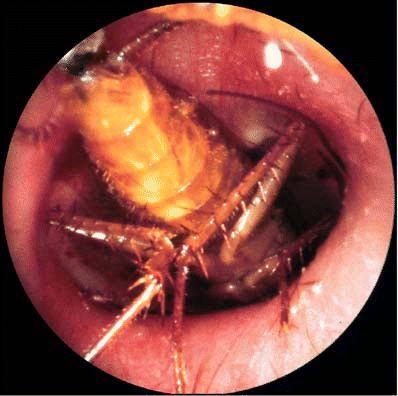
Quite a few of you had the same question after Friday’s post on objects in the ears, nose and throat:
What about insects that get in the ear, particularly when you are asleep? It’s pretty horrifying to think of some cockroach or other disgusting thing scratching around that close to your brain! What you don’t want to do is something that will irritate the critter to the point of puncturing your eardrum. Beyond freaking out, your next step should be pretty simple.
At home, consider doing what we do. If you have mineral oil, put a few drops in the ear. It’s the quickest and safest way to kill what’s in there. However, don’t delay coming to the local ER, urgent care facility or your doctor’s office. Any damage caused still needs to be evaluated.
Thanks for liking and following Straight, No Chaser! This public service provides a sample of what http://www.SterlingMedicalAdvice.com (SMA) will offer beginning November 1. Until then enjoy some our favorite posts and frequently asked questions as well as a daily note explaining the benefits of SMA membership. Please share our page with your Friends on WordPress, and we can be found on Facebook at SterlingMedicalAdvice.com and on Twitter at @asksterlingmd.
Copyright © 2013 · Sterling Initiatives, LLC · Powered by WordPress

Quite a few of you had the same question after Friday’s post on objects in the ears, nose and throat:
What about insects that get in the ear, particularly when you are asleep? It’s pretty horrifying to think of some cockroach or other disgusting thing scratching around that close to your brain! What you don’t want to do is something that will irritate the critter to the point of puncturing your eardrum. Beyond freaking out, your next step should be pretty simple.
At home, consider doing what we do. If you have mineral oil, put a few drops in the ear. It’s the quickest and safest way to kill what’s in there. However, don’t delay coming to the local ER, urgent care facility or your doctor’s office. Any damage caused still needs to be evaluated.
Thanks for liking and following Straight, No Chaser! This public service provides a sample of what http://www.SterlingMedicalAdvice.com (SMA) will offer beginning November 1. Until then enjoy some our favorite posts and frequently asked questions as well as a daily note explaining the benefits of SMA membership. Please share our page with your Friends on WordPress, and we can be found on Facebook at SterlingMedicalAdvice.com and on Twitter at @asksterlingmd.
Copyright © 2013 · Sterling Initiatives, LLC · Powered by WordPress
From the Health Library of SterlingMedicalAdvice.com: “What are some warning signs of mental illness?”
Symptoms of mental illness vary, but immediate and drastic changes in mood, thinking, and/or behaviors are common indicators. Should any such symptoms develop, seek medical attention immediately.
Thanks for liking and following Straight, No Chaser! This public service provides a sample of what http://www.SterlingMedicalAdvice.com (SMA) will offer beginning November 1. Until then enjoy some our favorite posts and frequently asked questions as well as a daily note explaining the benefits of SMA membership. Please share our page with your Friends on WordPress, and we can be found on Facebook at SterlingMedicalAdvice.com and on Twitter at @asksterlingmd.
Copyright © 2013 · Sterling Initiatives, LLC · Powered by WordPress
Symptoms of mental illness vary, but immediate and drastic changes in mood, thinking, and/or behaviors are common indicators. Should any such symptoms develop, seek medical attention immediately.
Thanks for liking and following Straight, No Chaser! This public service provides a sample of what http://www.SterlingMedicalAdvice.com (SMA) will offer beginning November 1. Until then enjoy some our favorite posts and frequently asked questions as well as a daily note explaining the benefits of SMA membership. Please share our page with your Friends on WordPress, and we can be found on Facebook at SterlingMedicalAdvice.com and on Twitter at @asksterlingmd.
Copyright © 2013 · Sterling Initiatives, LLC · Powered by WordPress
About www.SterlingMedicalAdvice.com: When Can and Should I Use It?
SMA is available 24 hours a day, seven days a week. Any time you have a health question or concern is a good time to chat or review the information contained within. For example, log in and chat with your SMA consultant …
• when you need medical advice regarding an immediate concern
• when you need general information about your medical condition
• when you are experiencing symptoms and want to know why
• when you want to learn information about a medical condition you may not be experiencing but which runs in your family
• when you want additional details on your upcoming procedure
• when you need medical advice regarding the best treatment option for you (e.g., emergency room vs. urgent care vs. your primary physician)
• when you need a second opinion on your new diagnosis
• when you need information about what to expect from a newly diagnosed condition
Thanks for liking and following Straight, No Chaser! This public service provides a sample of what http://www.SterlingMedicalAdvice.com (SMA) will offer beginning November 1. Until then enjoy some our favorite posts and frequently asked questions as well as a daily note explaining the benefits of SMA membership. Please share our page with your Friends on WordPress, and we can be found on Facebook at SterlingMedicalAdvice.com and on Twitter at @asksterlingmd.
Copyright © 2013 · Sterling Initiatives, LLC · Powered by WordPress
SMA is available 24 hours a day, seven days a week. Any time you have a health question or concern is a good time to chat or review the information contained within. For example, log in and chat with your SMA consultant …
• when you need medical advice regarding an immediate concern
• when you need general information about your medical condition
• when you are experiencing symptoms and want to know why
• when you want to learn information about a medical condition you may not be experiencing but which runs in your family
• when you want additional details on your upcoming procedure
• when you need medical advice regarding the best treatment option for you (e.g., emergency room vs. urgent care vs. your primary physician)
• when you need a second opinion on your new diagnosis
• when you need information about what to expect from a newly diagnosed condition
Thanks for liking and following Straight, No Chaser! This public service provides a sample of what http://www.SterlingMedicalAdvice.com (SMA) will offer beginning November 1. Until then enjoy some our favorite posts and frequently asked questions as well as a daily note explaining the benefits of SMA membership. Please share our page with your Friends on WordPress, and we can be found on Facebook at SterlingMedicalAdvice.com and on Twitter at @asksterlingmd.
Copyright © 2013 · Sterling Initiatives, LLC · Powered by WordPress
From the Health Library of SterlingMedicalAdvice.com: How Do I Cope?

What should I do if I’m having a hard time coping with recent changes in my life?
Adjusting to change or coping with a recent traumatic event is a difficult process and can lead to some of the same symptoms as mental illness if left unaddressed. Short-term treatment is often very effective to help prevent long-term distress, especially when you seek help sooner than later. Difficulty coping with change is normal, and talking with a professional to help make a healthy transition does not indicate you have a mental illness.
Thanks for liking and following Straight, No Chaser! This public service provides a sample of what http://www.SterlingMedicalAdvice.com (SMA) will offer beginning November 1. Until then enjoy some our favorite posts and frequently asked questions as well as a daily note explaining the benefits of SMA membership. Please share our page with your Friends on WordPress, and we can be found on Facebook at SterlingMedicalAdvice.com and on Twitter at @asksterlingmd.

What should I do if I’m having a hard time coping with recent changes in my life?
Adjusting to change or coping with a recent traumatic event is a difficult process and can lead to some of the same symptoms as mental illness if left unaddressed. Short-term treatment is often very effective to help prevent long-term distress, especially when you seek help sooner than later. Difficulty coping with change is normal, and talking with a professional to help make a healthy transition does not indicate you have a mental illness.
Thanks for liking and following Straight, No Chaser! This public service provides a sample of what http://www.SterlingMedicalAdvice.com (SMA) will offer beginning November 1. Until then enjoy some our favorite posts and frequently asked questions as well as a daily note explaining the benefits of SMA membership. Please share our page with your Friends on WordPress, and we can be found on Facebook at SterlingMedicalAdvice.com and on Twitter at @asksterlingmd.
Straight, No Chaser: What Would You Do If Your Tongue Suddenly Swelled? Learn About Angioedema
Here at Straight, No Chaser, we want you to know how to prevent disease and injury because that’s a lot easier than the alternative. However, if and when the time comes, you should also have a few tools in your arsenal to stave off a life-threatening situation. One of the more scary examples of needing help is acute swelling of your tongue, sometimes so much so that your airway appears as if it will be blocked.
The most common cause of acute tongue, lip or throat swelling is called angioedema. This is an allergic reaction and occurs in two varieties.
- A life-threatening allergic reaction (anaphylaxis) sometimes occurs shortly after an exposure to substance such as medicine, bee or other insect stings or food. It can throw your entire body into a state of shock, including involvement of multiple parts of the body. This can include massive tongue swelling, wheezing, low blood pressure resulting in blackouts and, of course, the rash typified by hives (urticaria).
- Sometimes lip, tongue and/or throat swelling may be the only symptoms. This is more typical of a delayed reaction to certain medications, such as types of blood pressure medications (ACE inhibitors and calcium channel blockers), estrogen and the class of pain medication called NSAIDs (non-steroidal anti-inflammatory drugs, such as ibuprofen)
With any luck, you would already know you’re at risk for this condition, and your physician may have prompted you to wear a medical alert bracelet or necklace. In these cases, your physician may have also given you medicines and instruction on how to take them in the event you feel as if your tongue is swelling and/or your throat is closing. These medicines would include epinephrine for injection, steroids and antihistamines such as Benadryl. As you dial 911 (my recommendation) or make your way to the nearest hospital, taking any or all of these medications could be life-saving. By the way, those are the among the same medicines you’ll be treated with upon arrival to the emergency room. In severe cases, you may need to be intubated (i.e. have a breathing tube placed) to maintain some opening of the airway.
If the swelling is (or assumed to be) due to any form of medication, symptoms will improve a few days after stopping it. If the swelling in this instance becomes severe enough, treatment may resemble that of the life-threatening variety.
There are few things better than cheating death. If you’re at risk, carry that injectable epinephrine (e.g. an Epi-pen). If you’re affected, take some Benadryl and/or steroids if you’ve been taught what dose to take, and most importantly, don’t wait to see if things improve. Get evaluated, get treated and get better!
I welcome your questions and comments.
Copyright © 2013 · Sterling Initiatives, LLC · Powered by WordPress
Here at Straight, No Chaser, we want you to know how to prevent disease and injury because that’s a lot easier than the alternative. However, if and when the time comes, you should also have a few tools in your arsenal to stave off a life-threatening situation. One of the more scary examples of needing help is acute swelling of your tongue, sometimes so much so that your airway appears as if it will be blocked.
The most common cause of acute tongue, lip or throat swelling is called angioedema. This is an allergic reaction and occurs in two varieties.
- A life-threatening allergic reaction (anaphylaxis) sometimes occurs shortly after an exposure to substance such as medicine, bee or other insect stings or food. It can throw your entire body into a state of shock, including involvement of multiple parts of the body. This can include massive tongue swelling, wheezing, low blood pressure resulting in blackouts and, of course, the rash typified by hives (urticaria).
- Sometimes lip, tongue and/or throat swelling may be the only symptoms. This is more typical of a delayed reaction to certain medications, such as types of blood pressure medications (ACE inhibitors and calcium channel blockers), estrogen and the class of pain medication called NSAIDs (non-steroidal anti-inflammatory drugs, such as ibuprofen)
With any luck, you would already know you’re at risk for this condition, and your physician may have prompted you to wear a medical alert bracelet or necklace. In these cases, your physician may have also given you medicines and instruction on how to take them in the event you feel as if your tongue is swelling and/or your throat is closing. These medicines would include epinephrine for injection, steroids and antihistamines such as Benadryl. As you dial 911 (my recommendation) or make your way to the nearest hospital, taking any or all of these medications could be life-saving. By the way, those are the among the same medicines you’ll be treated with upon arrival to the emergency room. In severe cases, you may need to be intubated (i.e. have a breathing tube placed) to maintain some opening of the airway.
If the swelling is (or assumed to be) due to any form of medication, symptoms will improve a few days after stopping it. If the swelling in this instance becomes severe enough, treatment may resemble that of the life-threatening variety.
There are few things better than cheating death. If you’re at risk, carry that injectable epinephrine (e.g. an Epi-pen). If you’re affected, take some Benadryl and/or steroids if you’ve been taught what dose to take, and most importantly, don’t wait to see if things improve. Get evaluated, get treated and get better!
I welcome your questions and comments.
Copyright © 2013 · Sterling Initiatives, LLC · Powered by WordPress
Straight, No Chaser: The Sexually Transmitted Disease Summary and The Week In Review, Sept. 29th, 2013
Based on your responses to the pictures posted this week, I should have renamed the blog, Scared Straight, No Chaser. The irony of it all is without exception, those pictures were very typical representations of the various sexually transmitted infections (STIs). Some of you didn’t like it, but I do appreciate that large numbers of you read it all. I hope you learned a lot and even more importantly were moved into (in)action. In case you missed anything:
On Sunday, we began the week with a look at bacterial vaginosis (BV), which may be associated with sex but is not an STI. It’s important for women to take an active effort to learn their bodies and the effects various activities have. Remember, BV is easily treated, but it’s always fair to take the opportunity to ensure that STIs aren’t also present.
On Monday, we reviewed the most common bacterial STI, chlamydia. Chlamydia is a really typical disease in that it’s contagious, easily transmitted and has substantial complications if not treated.
On Tuesday, we reviewed gonorrhea, which very often occurs in tandem with Chlamydia. Like chlamydia, it’s contagious, easily transmitted and has substantial complications if not treated. Think of gonorrhea when copious discharge is present, and don’t forget this includes the eyes, throat and joints.
On Wednesday, we reviewed the various stages of syphilis. This easily treatable yet very dangerous disease has the nasty habits of mimicking many other disease and spontaneously disappearing – which is not the same as it being cured. Instead, it progresses to more harmful stages if not identified and treated. Remember the association of syphilis with rashes involving the palms and soles.
On Thursday, we reviewed the treatment of syphilis. It is so important to understand how easily this is treated, so get checked. We also reviewed the story of the Tuskegee Experiment of Untreated Syphilis and how that (unethically) led to the knowledge we have about syphilis and the mandatory protections now in place for humans participating in medical experiments.
On Friday, we reviewed herpes. Many were shocked to learn these groups of small blisters (vesicles) can be found wherever an infection occurs, including the fingers, eyes and mouth. Think of herpes when you get a painful genital ulcer, and get checked ASAP.
On Saturday, we discussed the cauliflower ear, a too common, very preventable and apparently sought after (by certain athletes) condition seen in those with trauma to the ear. The trauma results in the accumulation of blood and clots, which damages and deforms the ear into its prototypical appearance. This leads to a life of pain and deformity.
Here are three final considerations on sexually transmitted infections.
1. They all tend to coexist. Your exposure to one places you at risk for acquiring others, including HIV/AIDS. What you don’t know can hurt you; in fact it can kill you.
2. Remember that until your partner is treated, you’re not treated.
3. Most of these diseases lead to conditions that physiologically make acquiring HIV/AIDS more likely. I didn’t discuss HIV/AIDS this week because it’s involved enough that it is its own topic with several different considerations. We’ll address these another time.
If you’re not prudent enough to practice safe sex, please be diligent enough to get tested and treated based on any suspicion. Even better – do both. The life you save will be your own.
Copyright © 2013 · Sterling Initiatives, LLC · Powered by WordPress
Based on your responses to the pictures posted this week, I should have renamed the blog, Scared Straight, No Chaser. The irony of it all is without exception, those pictures were very typical representations of the various sexually transmitted infections (STIs). Some of you didn’t like it, but I do appreciate that large numbers of you read it all. I hope you learned a lot and even more importantly were moved into (in)action. In case you missed anything:
On Sunday, we began the week with a look at bacterial vaginosis (BV), which may be associated with sex but is not an STI. It’s important for women to take an active effort to learn their bodies and the effects various activities have. Remember, BV is easily treated, but it’s always fair to take the opportunity to ensure that STIs aren’t also present.
On Monday, we reviewed the most common bacterial STI, chlamydia. Chlamydia is a really typical disease in that it’s contagious, easily transmitted and has substantial complications if not treated.
On Tuesday, we reviewed gonorrhea, which very often occurs in tandem with Chlamydia. Like chlamydia, it’s contagious, easily transmitted and has substantial complications if not treated. Think of gonorrhea when copious discharge is present, and don’t forget this includes the eyes, throat and joints.
On Wednesday, we reviewed the various stages of syphilis. This easily treatable yet very dangerous disease has the nasty habits of mimicking many other disease and spontaneously disappearing – which is not the same as it being cured. Instead, it progresses to more harmful stages if not identified and treated. Remember the association of syphilis with rashes involving the palms and soles.
On Thursday, we reviewed the treatment of syphilis. It is so important to understand how easily this is treated, so get checked. We also reviewed the story of the Tuskegee Experiment of Untreated Syphilis and how that (unethically) led to the knowledge we have about syphilis and the mandatory protections now in place for humans participating in medical experiments.
On Friday, we reviewed herpes. Many were shocked to learn these groups of small blisters (vesicles) can be found wherever an infection occurs, including the fingers, eyes and mouth. Think of herpes when you get a painful genital ulcer, and get checked ASAP.
On Saturday, we discussed the cauliflower ear, a too common, very preventable and apparently sought after (by certain athletes) condition seen in those with trauma to the ear. The trauma results in the accumulation of blood and clots, which damages and deforms the ear into its prototypical appearance. This leads to a life of pain and deformity.
Here are three final considerations on sexually transmitted infections.
1. They all tend to coexist. Your exposure to one places you at risk for acquiring others, including HIV/AIDS. What you don’t know can hurt you; in fact it can kill you.
2. Remember that until your partner is treated, you’re not treated.
3. Most of these diseases lead to conditions that physiologically make acquiring HIV/AIDS more likely. I didn’t discuss HIV/AIDS this week because it’s involved enough that it is its own topic with several different considerations. We’ll address these another time.
If you’re not prudent enough to practice safe sex, please be diligent enough to get tested and treated based on any suspicion. Even better – do both. The life you save will be your own.
Copyright © 2013 · Sterling Initiatives, LLC · Powered by WordPress
Straight, No Chaser: Syphilis – The Great Mimicker
Today, you will learn two phrases that you may not have previously heard: The Great Mimicker and MSM. Regarding another word you definitely should know, I’ll touch on it and will save for a separate post: Tuskegee.
Historically, syphilis really is the most important sexually transmitted disease (For what it’s worth, it’s thought that Columbus’ crew spread the disease from the Americas to Europe.). The great mimicker nickname as applied to syphilis exists because syphilis has many general symptoms that resemble and are often confused with other diseases. MSM points to the fact that treatment in the early stages is so complete that syphilis had been rapidly in decline – until it’s reemergence in a specific population. It is estimated that well over 60% of reported early stage cases of syphilis occurs in men who have sex with men (MSM).
In the first part of this review, I want to specifically address the symptoms, which are impressively and dramatically different depending on the stage.
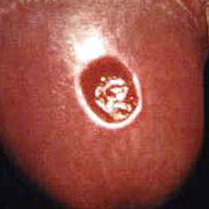
Stage I – Primary Syphilis: Primary syphilis usually presents with the presence of a single, painless sore (a chancre), located wherever it was contracted. As pictured above, the head (glans) of the penis is a typical site. The sore disappears in 3-6 weeks (with or without treatment), and if treatment wasn’t received, the disease progresses. Herein lies the problems. Because it’s painless, you ignore it, perhaps thinking it was a friction sore, or you never gave it much of a thought. Because it went away on its own, you forget about it, thinking that it got better. So sad, so wrong…
Stage II – Secondary Syphilis: When syphilis returns days to weeks (more typically) after the primary infection, it does so quite dramatically. Rashes can appear everywhere, including across your back (as noted above) and chest to on your palms and soles, in your mouth, groin, vagina, anus, or armpits. The rash could be warts (condyloma lata) or flat. You should be scared, but you might not be because… the rash and the other symptoms again will disappear on its own. Despite what you may think intuitively, you really don’t want that to happen.
Latent Syphilis: Dormant syphilis can stay that way for decades after secondary syphilis has occurred. What you don’t know can hurt you. Syphilis can be transmitted during the earlier portion of latent phases, including to an unborn child.

Tertiary Syphilis: Late stage syphilis is a disturbing thing to see (and obviously experience). The disease can result in death, causing damage to the brain, heart, liver, bones, joints, eyes, the nervous system and blood vessels. Before it kills you, it can result in blindness, paralysis, dementia and loss of motor control. If you don’t know how the research discovering all of this was conducted, for now I’ll just say it was one of the most shameful acts of medical history. I’ll blog on it later. The individuals in the above picture were alive when these pictures were taken, by the way.
A special note: The bacteria causing syphilis is rather aggressive, so much so that it can be transmitted by oral, anal or genital sexual contact. By oral, I also mean kissing. Pay attention to those oral sores. Furthermore, syphilis gets transmitted from mother to unborn child. This is a devastating occurrence – if untreated, a child may be born prematurely, with low birth weight or even stillborn. If untreated, once born, a child may suffer deafness, seizures and cataracts before death.
All of the pictures in this posts are typical representations of the various stages of syphilis, and I’ve seen them all. These are not meant to provide any shock value other than demonstrating what occurs with progression of the disease. Later, I will discuss treatment, risks and other considerations. I don’t think you’ll want to miss the rest of the story. That really is shocking – and horrible.
Feel free to offer comments or ask questions.
Copyright © 2013 · Sterling Initiatives, LLC · Powered by WordPress
Today, you will learn two phrases that you may not have previously heard: The Great Mimicker and MSM. Regarding another word you definitely should know, I’ll touch on it and will save for a separate post: Tuskegee.
Historically, syphilis really is the most important sexually transmitted disease (For what it’s worth, it’s thought that Columbus’ crew spread the disease from the Americas to Europe.). The great mimicker nickname as applied to syphilis exists because syphilis has many general symptoms that resemble and are often confused with other diseases. MSM points to the fact that treatment in the early stages is so complete that syphilis had been rapidly in decline – until it’s reemergence in a specific population. It is estimated that well over 60% of reported early stage cases of syphilis occurs in men who have sex with men (MSM).
In the first part of this review, I want to specifically address the symptoms, which are impressively and dramatically different depending on the stage.

Stage I – Primary Syphilis: Primary syphilis usually presents with the presence of a single, painless sore (a chancre), located wherever it was contracted. As pictured above, the head (glans) of the penis is a typical site. The sore disappears in 3-6 weeks (with or without treatment), and if treatment wasn’t received, the disease progresses. Herein lies the problems. Because it’s painless, you ignore it, perhaps thinking it was a friction sore, or you never gave it much of a thought. Because it went away on its own, you forget about it, thinking that it got better. So sad, so wrong…
Stage II – Secondary Syphilis: When syphilis returns days to weeks (more typically) after the primary infection, it does so quite dramatically. Rashes can appear everywhere, including across your back (as noted above) and chest to on your palms and soles, in your mouth, groin, vagina, anus, or armpits. The rash could be warts (condyloma lata) or flat. You should be scared, but you might not be because… the rash and the other symptoms again will disappear on its own. Despite what you may think intuitively, you really don’t want that to happen.
Latent Syphilis: Dormant syphilis can stay that way for decades after secondary syphilis has occurred. What you don’t know can hurt you. Syphilis can be transmitted during the earlier portion of latent phases, including to an unborn child.

Tertiary Syphilis: Late stage syphilis is a disturbing thing to see (and obviously experience). The disease can result in death, causing damage to the brain, heart, liver, bones, joints, eyes, the nervous system and blood vessels. Before it kills you, it can result in blindness, paralysis, dementia and loss of motor control. If you don’t know how the research discovering all of this was conducted, for now I’ll just say it was one of the most shameful acts of medical history. I’ll blog on it later. The individuals in the above picture were alive when these pictures were taken, by the way.
A special note: The bacteria causing syphilis is rather aggressive, so much so that it can be transmitted by oral, anal or genital sexual contact. By oral, I also mean kissing. Pay attention to those oral sores. Furthermore, syphilis gets transmitted from mother to unborn child. This is a devastating occurrence – if untreated, a child may be born prematurely, with low birth weight or even stillborn. If untreated, once born, a child may suffer deafness, seizures and cataracts before death.
All of the pictures in this posts are typical representations of the various stages of syphilis, and I’ve seen them all. These are not meant to provide any shock value other than demonstrating what occurs with progression of the disease. Later, I will discuss treatment, risks and other considerations. I don’t think you’ll want to miss the rest of the story. That really is shocking – and horrible.
Feel free to offer comments or ask questions.
Copyright © 2013 · Sterling Initiatives, LLC · Powered by WordPress
Straight, No Chaser: The Week In Review, September 22nd, 2013

You’ve been after me all week with two questions, so here goes:
1) Have you dropped back to one post a day, and why?
Not necessarily; it depends on the topic and what else I have going on. As some of you are aware, I’m in the midst of a pretty significant effort to assist with a public health initiative addressing implementation of the Affordable Care Act. As such, my time is limited. That said, please continue to request and suggest topics. If they’re timely and have appeal to a large audience, I’ll get to it!
2) What’s with the commercials?
First of all some of them are hilarious. I particularly like Burt Reynolds and Cap’n Crunch in the bathtub, Neely and the Honey Nut Cheerios Bee, and the little baby (I won’t spoil the punch line.). WordPress recoups the costs of producing this blog by placing commercials. That allows the blog to be produced without additional costs. Thanks for your support, and I’m glad the information seems to be making a difference for many of you.
Now to the Straight, No Chaser Week in Review.
On Sunday, we addressed septic shock. It’s difficult to address topics that represent part of the final pathway to death, and I know many of you have lost loved ones as a result of septic shock finishing off whatever the initial illness was. I hope that I addressed this topic in a way that offered you clarity and not any insensitivity for what has to be among your most uncomfortable memories.
On Monday, we addressed a very important part of the future of medicine, and nurses’ various roles in it. You should be aware of these changes, given how they will affect you. We also addressed the basics of diabetes. I hope you paid attention. I describe diabetes as the Terminator of common diseases. It is both insidious and relentless. It takes a life-long effort to stay on top of things, lest you end up with a foot or leg amputated, blind, or fighting infections, seemingly indefinitely.
On Tuesday, we looked at hypoglycemia, which often occurs as a result of overmedication of diabetics but also occurs as a result of some potentially fatal diseases. In the emergency room, hypoglycemia is the first thing we assume is occurring and attend to in most patients with any altered mental status. It’s just that important – and potentially deadly. We also addressed the initial actions victims should take in the face of a sexual assault. Special thanks to Dorothy Kozakowski, Vice-President of the Illinois Chapter of the International Association of Forensic Nurses for collaborating on this post. Please remember: get away and get to help as quickly as you can without doing anything to yourself. I hope you never have to experience this, but statistically, I know that’s not the case.
On Wednesday, we looked at the most common abdominal cause of surgery in most ages: appendicitis. Symptoms vary significantly, but if you sequentially get abdominal pain, loss of appetite (with possible nausea and vomiting) and a fever, you might want to get to your local emergency department. A ruptured appendix could be fatal. We also reviewed blood clots in your legs (aka deep venous thrombosis, aka DVTs). Please review the risk factors for these and lower your risk. Given that these clots break off, go to the lungs and brain, and lead to strokes or death, it’s worth knowing.
On Thursday, we reviewed the various types of hernias that occur. As with appendicitis, there are risk factors you should know and potentially deadly consequences for failure to get these addressed. Regarding the variety that occur in your groin, ask your physician to show you how to check yourself. Learn how to lift properly!
On Friday, we addressed medical conditions that tend to have a higher risk of occurring while you’re flying. If you like tips, it’s worth knowing those items suggested that could save a life (be reminded that there are no medical crews on your flights).
On Saturday, we began a week-long series on sexually transmitted infections (aka STIs, aka STDs). I’m ok with you reading in silence. Just read. Knowledge is power. You’d much rather I answer your questions now as opposed when you’re about to be on the business end of a needle, speculum or swab (gentlemen that last one is especially for you). We’ll be looking at individual conditions all this upcoming week – but I refuse to call it STD week. That’s every week.
Thank you for your ongoing readership. Have a great upcoming week.
Copyright © 2013 · Sterling Initiatives, LLC · Powered by WordPress

You’ve been after me all week with two questions, so here goes:
1) Have you dropped back to one post a day, and why?
Not necessarily; it depends on the topic and what else I have going on. As some of you are aware, I’m in the midst of a pretty significant effort to assist with a public health initiative addressing implementation of the Affordable Care Act. As such, my time is limited. That said, please continue to request and suggest topics. If they’re timely and have appeal to a large audience, I’ll get to it!
2) What’s with the commercials?
First of all some of them are hilarious. I particularly like Burt Reynolds and Cap’n Crunch in the bathtub, Neely and the Honey Nut Cheerios Bee, and the little baby (I won’t spoil the punch line.). WordPress recoups the costs of producing this blog by placing commercials. That allows the blog to be produced without additional costs. Thanks for your support, and I’m glad the information seems to be making a difference for many of you.
Now to the Straight, No Chaser Week in Review.
On Sunday, we addressed septic shock. It’s difficult to address topics that represent part of the final pathway to death, and I know many of you have lost loved ones as a result of septic shock finishing off whatever the initial illness was. I hope that I addressed this topic in a way that offered you clarity and not any insensitivity for what has to be among your most uncomfortable memories.
On Monday, we addressed a very important part of the future of medicine, and nurses’ various roles in it. You should be aware of these changes, given how they will affect you. We also addressed the basics of diabetes. I hope you paid attention. I describe diabetes as the Terminator of common diseases. It is both insidious and relentless. It takes a life-long effort to stay on top of things, lest you end up with a foot or leg amputated, blind, or fighting infections, seemingly indefinitely.
On Tuesday, we looked at hypoglycemia, which often occurs as a result of overmedication of diabetics but also occurs as a result of some potentially fatal diseases. In the emergency room, hypoglycemia is the first thing we assume is occurring and attend to in most patients with any altered mental status. It’s just that important – and potentially deadly. We also addressed the initial actions victims should take in the face of a sexual assault. Special thanks to Dorothy Kozakowski, Vice-President of the Illinois Chapter of the International Association of Forensic Nurses for collaborating on this post. Please remember: get away and get to help as quickly as you can without doing anything to yourself. I hope you never have to experience this, but statistically, I know that’s not the case.
On Wednesday, we looked at the most common abdominal cause of surgery in most ages: appendicitis. Symptoms vary significantly, but if you sequentially get abdominal pain, loss of appetite (with possible nausea and vomiting) and a fever, you might want to get to your local emergency department. A ruptured appendix could be fatal. We also reviewed blood clots in your legs (aka deep venous thrombosis, aka DVTs). Please review the risk factors for these and lower your risk. Given that these clots break off, go to the lungs and brain, and lead to strokes or death, it’s worth knowing.
On Thursday, we reviewed the various types of hernias that occur. As with appendicitis, there are risk factors you should know and potentially deadly consequences for failure to get these addressed. Regarding the variety that occur in your groin, ask your physician to show you how to check yourself. Learn how to lift properly!
On Friday, we addressed medical conditions that tend to have a higher risk of occurring while you’re flying. If you like tips, it’s worth knowing those items suggested that could save a life (be reminded that there are no medical crews on your flights).
On Saturday, we began a week-long series on sexually transmitted infections (aka STIs, aka STDs). I’m ok with you reading in silence. Just read. Knowledge is power. You’d much rather I answer your questions now as opposed when you’re about to be on the business end of a needle, speculum or swab (gentlemen that last one is especially for you). We’ll be looking at individual conditions all this upcoming week – but I refuse to call it STD week. That’s every week.
Thank you for your ongoing readership. Have a great upcoming week.
Copyright © 2013 · Sterling Initiatives, LLC · Powered by WordPress
Straight, No Chaser: Life Begins (To End) at 40 (Unless It Doesn’t) – The Cardiopulmonary (Heart and Lung) System
The fourth part of this series looks at your heart and lungs. One thing the heart and lung share in common is, left to their own devices, they could function normally for much longer than typically ends up occurring. It’s important to discuss because heart disease is the most common cause of death in people 65 and over, and it is also the most frequent cause of activity limitations. Let’s quickly review changes, challenges and solutions.
Heart Changes: Coronary artery disease increases as your activity declines. Blockages accumulate on the inside of your arteries, and they harden as they lose their elasticity. Both of these factors resulting in lessened blood flow. High blood pressure increases with age, independently and as a result of this.
Lung Changes: The air sacs, airways, and tissues lose elasticity and become more rigid with age. In general however, serious disease notwithstanding, the respiratory system can serve one well throughout a very long life. However, if you’re a smoker or have lung disease (e.g. asthma, COPD), the reversible damage to the lungs starts becoming irreversible about age 35. At that time, you in effect begin tearing out useful lung tissue, which diminishes your respiratory capacity and sets you up for chronic bronchitis and cancer, as the body attempts to repair this damage and does so incorrectly.
Challenges: In the absence of structural disease or continuing to expose yourself to toxins (e.g. cigarettes), the effects of these changes on our health status need not be severe. The social implications of the effects of normal changes due to aging often would not hamper reasonable normal functioning. The real challenge is to avoid inhaling toxins that will harm you (duh, right?).
Solutions: This is much simpler than you’d think and mostly involves prevention. The biological changes can be greatly diminished and held off by a regular, strenuous exercise regimen that causes deep breathing and elevation of your heart rate over a period of time and by avoidance of toxins, especially cigarette smoke and fatty foods. Your heart and lungs are well situated for the long haul in the absence of bad genes and bad habits.
Copyright © 2013 · Sterling Initiatives, LLC · Powered by WordPress
The fourth part of this series looks at your heart and lungs. One thing the heart and lung share in common is, left to their own devices, they could function normally for much longer than typically ends up occurring. It’s important to discuss because heart disease is the most common cause of death in people 65 and over, and it is also the most frequent cause of activity limitations. Let’s quickly review changes, challenges and solutions.
Heart Changes: Coronary artery disease increases as your activity declines. Blockages accumulate on the inside of your arteries, and they harden as they lose their elasticity. Both of these factors resulting in lessened blood flow. High blood pressure increases with age, independently and as a result of this.
Lung Changes: The air sacs, airways, and tissues lose elasticity and become more rigid with age. In general however, serious disease notwithstanding, the respiratory system can serve one well throughout a very long life. However, if you’re a smoker or have lung disease (e.g. asthma, COPD), the reversible damage to the lungs starts becoming irreversible about age 35. At that time, you in effect begin tearing out useful lung tissue, which diminishes your respiratory capacity and sets you up for chronic bronchitis and cancer, as the body attempts to repair this damage and does so incorrectly.
Challenges: In the absence of structural disease or continuing to expose yourself to toxins (e.g. cigarettes), the effects of these changes on our health status need not be severe. The social implications of the effects of normal changes due to aging often would not hamper reasonable normal functioning. The real challenge is to avoid inhaling toxins that will harm you (duh, right?).
Solutions: This is much simpler than you’d think and mostly involves prevention. The biological changes can be greatly diminished and held off by a regular, strenuous exercise regimen that causes deep breathing and elevation of your heart rate over a period of time and by avoidance of toxins, especially cigarette smoke and fatty foods. Your heart and lungs are well situated for the long haul in the absence of bad genes and bad habits.
Copyright © 2013 · Sterling Initiatives, LLC · Powered by WordPress
Straight, No Chaser: When Sex Hurts Her – Vaginismus
The human body is fascinating and mysterious in so many different ways. Unfortunately, that’s not always a good thing. Not every medical condition has to be life threatening to have a powerful and detrimental impact on one’s life. Vaginismus is an example of that. It’s a condition in which women suffer involuntary contractions of the floor of the vaginal walls. These contractions can be so violent and incapacitating that it renders sex very painful and uncomfortable at best and physically impossible at worst. No, this is not esoterica. Many women suffer through this, not knowing what it is or ascribing the pain to ‘size’.
Here’s three things you need to know:
She’s not faking it.
Vaginismus is horrible for the sufferer, as you’d imagine, and it’s a tremendous stress on relationships. It is the number one cause of unconsummated marriages, and can be complete or situational. It may be complete, impacting ability for a physician to complete a pelvic examination or for a woman to even place a tampon. These contractions can be reflex occurrences such that the symptoms occur when presented with any effort to penetrate the vagina. That said, the reflex is thought to be physiologically learned, and it has been demonstrated that it can be unlearned (Consider your immediate impulse to lift your arm when a fast object comes at you; one episode of vaginismus can prompt a lifetime of similar reactions during efforts at sex.).
Vaginismus can be cured.
It stands to reason that in the many cases in which vaginismus is a learned reflex, the reflex can be overcome. Muscle training and control are the keys to overcoming vaginismus and is a process that can be accomplished over weeks to months. The good news is developing this level of training and control can also have wonderful benefits for couples that do get past the problem. Many women are familiar with Kegel exercises from prenatal classes. Application of these in the correct manner (with systematic progression until penetration is possible) provides success in approximately 90% of patients. If you require details, feel free to ask, or discuss this with your physician.
Vaginismus requires patience (and flexibility) to overcome.
Healthy sex lives are enjoyed by many couples without penetration. This is an important frame of mind to have, less the additional stress can hinder treatment and torpedo the relationship. It may seem like a lot to ask for some, but believe me, many couple maintain happy relationships in the midst of this, either during treatment or throughout a lifetime of suffering through it. Taking this mindset into the period during which treatment is ongoing can lead to a very happy outcome once the vaginismus has been overcome.
I welcome your questions or comments.
Copyright © 2013 · Sterling Initiatives, LLC · Powered by WordPress
The human body is fascinating and mysterious in so many different ways. Unfortunately, that’s not always a good thing. Not every medical condition has to be life threatening to have a powerful and detrimental impact on one’s life. Vaginismus is an example of that. It’s a condition in which women suffer involuntary contractions of the floor of the vaginal walls. These contractions can be so violent and incapacitating that it renders sex very painful and uncomfortable at best and physically impossible at worst. No, this is not esoterica. Many women suffer through this, not knowing what it is or ascribing the pain to ‘size’.
Here’s three things you need to know:
She’s not faking it.
Vaginismus is horrible for the sufferer, as you’d imagine, and it’s a tremendous stress on relationships. It is the number one cause of unconsummated marriages, and can be complete or situational. It may be complete, impacting ability for a physician to complete a pelvic examination or for a woman to even place a tampon. These contractions can be reflex occurrences such that the symptoms occur when presented with any effort to penetrate the vagina. That said, the reflex is thought to be physiologically learned, and it has been demonstrated that it can be unlearned (Consider your immediate impulse to lift your arm when a fast object comes at you; one episode of vaginismus can prompt a lifetime of similar reactions during efforts at sex.).
Vaginismus can be cured.
It stands to reason that in the many cases in which vaginismus is a learned reflex, the reflex can be overcome. Muscle training and control are the keys to overcoming vaginismus and is a process that can be accomplished over weeks to months. The good news is developing this level of training and control can also have wonderful benefits for couples that do get past the problem. Many women are familiar with Kegel exercises from prenatal classes. Application of these in the correct manner (with systematic progression until penetration is possible) provides success in approximately 90% of patients. If you require details, feel free to ask, or discuss this with your physician.
Vaginismus requires patience (and flexibility) to overcome.
Healthy sex lives are enjoyed by many couples without penetration. This is an important frame of mind to have, less the additional stress can hinder treatment and torpedo the relationship. It may seem like a lot to ask for some, but believe me, many couple maintain happy relationships in the midst of this, either during treatment or throughout a lifetime of suffering through it. Taking this mindset into the period during which treatment is ongoing can lead to a very happy outcome once the vaginismus has been overcome.
I welcome your questions or comments.
Copyright © 2013 · Sterling Initiatives, LLC · Powered by WordPress
Straight, No Chaser: The Battle of Antioxidants and Free Radicals
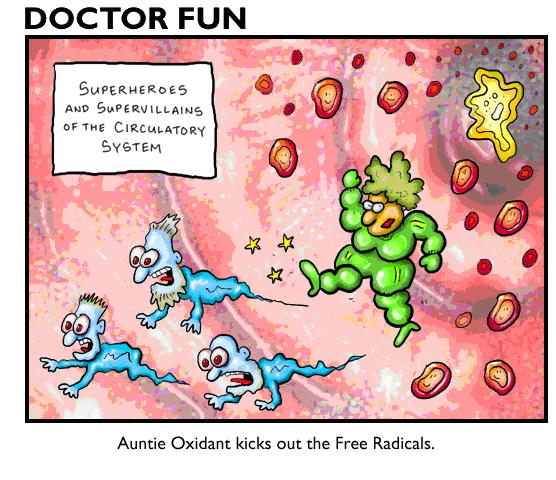
We engage in a lot of fads and off the wall activity to pursue health instead of following tried and true principles of basic science. One thing that I wish didn’t fit that trend is use of supplemental antioxidants. Before talking about using antioxidants, allow me to discuss why they’re necessary.
Free radicals are like the Tasmanian Devil. These molecules are byproducts of many activities that create cell damage. Think about cigarette smoke, trauma (even vigorous exercise), excessive heat and sunlight (and its radiation), to name a few examples. The process of creating and releasing these molecules is called oxidation. The key point is free radicals are unstable and too many of them lead to a process called oxidative stress. This process is implicated in the development of many illnesses, including Alzheimer’s disease, cancer, cataracts and other eye diseases, cardiovascular diseases, diabetes and Parkinson’s disease.
Antioxidants are substances that prevent or delay cell damage caused by free radicals. Antioxidants may be natural or artificial (e.g. man-made). The healthy diets we’re always asking you to eat (e.g. those high in fruits and vegetables) contain lots of antioxidants; in fact this has a lot to do with why we believe they’re good for us. Of course, now you can get many forms of antioxidants in pills. That’s where things get a little less certain.
Logically, you’d think that if some antioxidants are good, a lot would be better, and they would really be effective against free radicals. Furthermore, you’d think a convenient and efficient way of doing this would be putting a lot of antioxidants in a pill. Unfortunately, medical science (including over 100,000 people studied) has shown this not to be as simplistic as our logic would have us believe. I can’t say this any simpler. Antioxidant supplements have not been shown to be helpful in preventing disease. In fact, high-dose supplementation has been shown to have harmful effects, including increasing the risks of lung and prostate cancer. In short, our body doesn’t function in as linear a manner as we would like to think.
Here’s your take home message: We have yet proven that we’re able to cheat Mother Nature. You will not find your health in a bottle. Diet and exercise remain the champions of the battle of pursuing good health. Get your antioxidants the old fashioned way – in your fruits and veggies. Here’s a nice chart for your reference.


We engage in a lot of fads and off the wall activity to pursue health instead of following tried and true principles of basic science. One thing that I wish didn’t fit that trend is use of supplemental antioxidants. Before talking about using antioxidants, allow me to discuss why they’re necessary.
Free radicals are like the Tasmanian Devil. These molecules are byproducts of many activities that create cell damage. Think about cigarette smoke, trauma (even vigorous exercise), excessive heat and sunlight (and its radiation), to name a few examples. The process of creating and releasing these molecules is called oxidation. The key point is free radicals are unstable and too many of them lead to a process called oxidative stress. This process is implicated in the development of many illnesses, including Alzheimer’s disease, cancer, cataracts and other eye diseases, cardiovascular diseases, diabetes and Parkinson’s disease.
Antioxidants are substances that prevent or delay cell damage caused by free radicals. Antioxidants may be natural or artificial (e.g. man-made). The healthy diets we’re always asking you to eat (e.g. those high in fruits and vegetables) contain lots of antioxidants; in fact this has a lot to do with why we believe they’re good for us. Of course, now you can get many forms of antioxidants in pills. That’s where things get a little less certain.
Logically, you’d think that if some antioxidants are good, a lot would be better, and they would really be effective against free radicals. Furthermore, you’d think a convenient and efficient way of doing this would be putting a lot of antioxidants in a pill. Unfortunately, medical science (including over 100,000 people studied) has shown this not to be as simplistic as our logic would have us believe. I can’t say this any simpler. Antioxidant supplements have not been shown to be helpful in preventing disease. In fact, high-dose supplementation has been shown to have harmful effects, including increasing the risks of lung and prostate cancer. In short, our body doesn’t function in as linear a manner as we would like to think.
Here’s your take home message: We have yet proven that we’re able to cheat Mother Nature. You will not find your health in a bottle. Diet and exercise remain the champions of the battle of pursuing good health. Get your antioxidants the old fashioned way – in your fruits and veggies. Here’s a nice chart for your reference.


